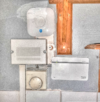I had the same problem,

so added a third thermostat in parallel. Bottom left works just the flat, top centre and bottom right work the main house. Top centre also does the DHW.
In theroy once the Wiser hub was fitted bottom right, we could stop using the top Nest thermostat hub. The problem with the Nest Gen 3 is it does not connect in a meaning full way to the TRV heads, and the problem with the Wiser is it uses batteries, so if they go discharged then no heating.
There is nothing to stop having a thermostat in every room, and the Wiser system would allow this, however remember the TRV is a thermostat, so really no need for any wall thermostats if the TRV's are linked.
With the exception of Nest e, the thermostat base needs power. My thermostat base is in the flat, as the boiler is there, and is supplied from the solar inverter, so central heating continues to run in a power cut. With this in mind the thermostat base needs to be supplied from same circuit as the boiler, or batteries. This also ensures the thermostat can't by-pass fuses in the boiler, so any 230 volt thermostat should be supplied from the boiler.
However as long as volt free contacts on the thermostat, there is no real reason why it must be supplied from boiler, Nest for example do a USB powered thermostat option, and the USB power supply is unlikely to be on same circuit as the boiler.
So job one, decide where you want the base, next to motorised valves, or boiler are favourite. If motorised valve is used, normally the thermostat works the valve, and the micro switch in the valve works the boiler. We work with the Honeywell plans in the main. S Plan uses multi-two-port-valves, Y plan uses three port valves, and C plan can have no valves.
We are told location is important,
the picture shows the air flow, so the thermostat needs to be in that flow, at the side of the radiators works well, i.e. the TRV, but with wall thermostat the opposite wall.
A lot depends what the opposite wall has behind it, on an outside wall it can be cooled by the wall, the Wiser comes with a stand, so can sit on a dresser or table. The Nest Gen 3 lights up as I walk past it, so easy to read, the Wiser is battery powered and they would not last long if it auto lit up, so need to touch it. Both can be read with the phone.
I have tried geofencing (having the phone auto turn heating on/off as we leave and return to house) I used Nest Gen 3, and the recovery time was too long, Wiser uses IFTTT but only tried that with Energenie, again recovery time was too long. Theory is great, if you work 75 miles from home, at 50 miles from home it can turn on heating, however in practice most don't allow distance to be set, all you can set is the eco and comfort temperature, so drops to 17ºC when away (Eco) and back to 20ºC when home (Comfort) but I found it took too long to raise all rooms 3ºC so times work better, so you can set a sequence so rooms start to heat one at a time, maybe only 10 minutes between rooms, but it means room one radiator hot far faster, with maybe bedrooms a few hours latter.
I find we want both bedrooms at around the same time, so only one, the coldest, needs a linked TRV head, the other programmed yes, but not linked.
I would say, decide what you want in 5 years time, and then start moving towards it. As good linked hubs are expensive, I made an error, had I started with Wiser not Nest, would have not needed a second thermostat.


